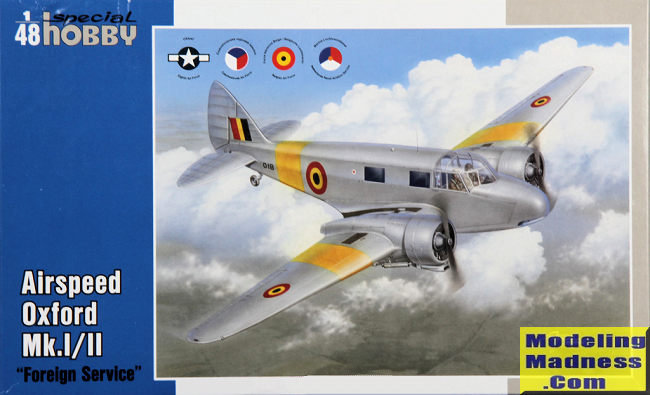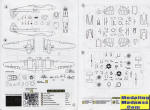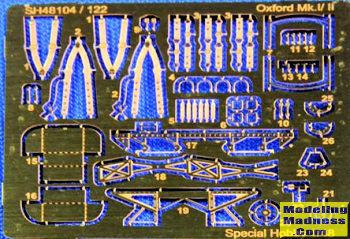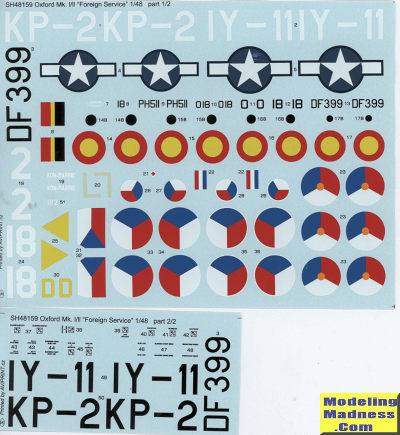
Special Hobby 1/48 Oxford I/II
| KIT #: | SH 48159 |
| PRICE: | $37.69 shipped. |
| DECALS: | Six options |
| REVIEWER: | Scott Van Aken |
| NOTES: | Short run |

| HISTORY |
The Airspeed AS.10 Oxford was a twin-engine monoplane aircraft developed and manufactured by Airspeed. It saw widespread use for training British Commonwealth aircrews in navigation, radio-operating, bombing and gunnery roles throughout the Second World War.
The Oxford was developed by Airspeed during the 1930s in response to a requirement for a capable trainer aircraft that conformed with Specification T.23/36, which had been issued by the British Air Ministry. Its basic design is derived from the company's earlier AS.6 Envoy, a commercial passenger aircraft. Performing its maiden flight on 19 June 1937, it was rapidly put into production as part of a rapid expansion of the Royal Air Force (RAF) in anticipation of a large-scale conflict.
As a consequence of the outbreak of war, many thousands of Oxfords would be ordered by Britain and its allies, including Australia, Canada, France, New Zealand, Poland, and the United States. Following the end of the conflict, the Oxford continued to achieve export sales for some time, equipping the newly formed air forces of Egypt, India, Israel, and Yugoslavia. It was considered to be a capable trainer aircraft throughout the conflict, as well as being used a general-purpose type. A large number of Oxfords have been preserved on static display.
| THE KIT |
 Special
Hobby has released at least four boxings of this kit. One of the nice things
about widely used aircraft is that you can do this for little more than a new
decal sheet and updated instructions. The only real difference between the Mk.I
and Mk.II was the latter had a turret for gunnery trainer, though by the start
of the war, the turrets had been removed.
Special
Hobby has released at least four boxings of this kit. One of the nice things
about widely used aircraft is that you can do this for little more than a new
decal sheet and updated instructions. The only real difference between the Mk.I
and Mk.II was the latter had a turret for gunnery trainer, though by the start
of the war, the turrets had been removed.
 As you can
see by the parts layout, the kit relies on some photo etch to provide detail to
the kit. Much of this is concentrated in the cockpit in terms of belts, levers
and the seat mounts as well as the usual external pieces. There are also resin
parts and again, these are used for detail, the most prominent being the
different oil cooler intakes for the engines. Note that you have to pretty well
decide which markings option you will be building towards rather early in the
process. The instructions offer multiple build steps depending on which plane
you are building. The wise builder will thoroughly explore the instructions
prior to starting. There are profiles in the center of the instruction booklet
that highlight the major differences between variations.
As you can
see by the parts layout, the kit relies on some photo etch to provide detail to
the kit. Much of this is concentrated in the cockpit in terms of belts, levers
and the seat mounts as well as the usual external pieces. There are also resin
parts and again, these are used for detail, the most prominent being the
different oil cooler intakes for the engines. Note that you have to pretty well
decide which markings option you will be building towards rather early in the
process. The instructions offer multiple build steps depending on which plane
you are building. The wise builder will thoroughly explore the instructions
prior to starting. There are profiles in the center of the instruction booklet
that highlight the major differences between variations.
There is a considerable amount of detail in the cabin area behind the cockpit. I'm not sure how much of that will actually be visible in the completed model, but most of us will install the bits anyway. The cabin windows need to be installed from the inside.
Main gear wells are built
up from a lower section that is different depending on the option you are
building, an upper section as well as forward and aft wall pieces. With this
done, the wings can be assembled. The engine is trapped between upper and lower
cowling halves then attached to the nacelles. One then builds up the main
landing gear and glues those into the wells. Any gear doors are then attached.
This is followed by exhaust, your opti on
on oil cooler intakes and the tail gear parts. Though the cockpit and lower
forward fuselage clear bits are attached eariler in the instructions, many of us
will want to do these near the end.
on
on oil cooler intakes and the tail gear parts. Though the cockpit and lower
forward fuselage clear bits are attached eariler in the instructions, many of us
will want to do these near the end.
Instructions are booklet style with the full color painting and marking information in the back. Gunze paint references are provided. There are six options. First is the silver painted Belgian option as shown in the box art. This is followed by a USAAF version in standard RAF WWII trainer colors of dark green/dark earth over yellow. Three different Czech options are next with the planes in dark green/dark earth over sky. All have different insignia and/or markings. The final option is a Dutch navy plane in scheme that is difficult to decipher. There is dark earth/dark green upper with extra dark sea grey undersides. The dark green on this one looks to be the same shade as the EDSG and the dark earth is VERY dark. Decals are nicely printed and should prove to be excellent. The kit also provides a set of canopy masks which are not shown.
| CONCLUSIONS |
This is another type that is not wildly popular, but it is a very nice looking and important British aircraft that lasted well beyond the war in a variety of post-war air arms.
| REFERENCES |
https://en.wikipedia.org/wiki/Airspeed_Oxford
July 2018
Copyright ModelingMadness.com. All rights reserved.
If you would like your product reviewed fairly and fairly quickly, please contact the editor or see other details in the Note to Contributors.
Back to the Main Page Back to the Review Index Page Back to the Previews Index Page